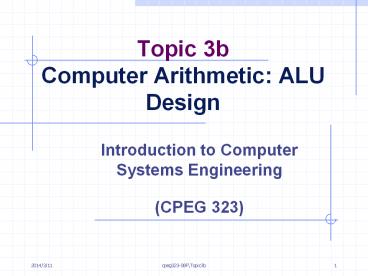Topic 3b Computer Arithmetic: ALU Design - PowerPoint PPT Presentation
Title:
Topic 3b Computer Arithmetic: ALU Design
Description:
and, or, andi, ori. bitwise operations. Total number of operations = 10. 9/20/09 ... Verify solution works as a whole. Example: Separate immediate instructions ... – PowerPoint PPT presentation
Number of Views:64
Avg rating:3.0/5.0
Title: Topic 3b Computer Arithmetic: ALU Design
1
Topic 3b Computer Arithmetic ALU Design
- Introduction to Computer Systems Engineering
- (CPEG 323)
2
Design Process
- Design
- components
- how they are put together
- Top Down decomposition
- of complex functions
- Bottom-up composition of primitive
3
Problem Design an ALU
- Operations
- add, addu, sub, subu, addi, addiu
- 2s complement adder/sub with overflow detection
- and, or, andi, ori
- bitwise operations
- Total number of operations 10
4
Design divide conquer method
- Break the problem into simpler parts
- Work on the parts
- Put pieces together
- Verify solution works as a whole
- Example Separate immediate instructions from the
rest. - Process immediates before ALU
- ALU inputs now uniform
- 6 non-immediate operations remain
- Need 3 bits to specify the ALU mode
5
Design First Steps
- Complete functional specification first
- inputs 2 x 32-bit operands A, B, 3-bit operation
code - outputs 32-bit result R, 1-bit carry, 1 bit
overflow - operations add, addu, sub, subu, and, or
- High-level block diagram completed next
6
Design Reducing the problem to something simpler
- For our ALU, reduce 32-bit problem into simpler
1-bit slices. - Changes big combinational problem to a small
combinational problem - Put the pieces together to solve the big problem.
7
Designing with lower-level block diagrams
1-Bit ALU block
Replicate 32 times for a 32-bit ALU
Replicate 32 times for a 32-bit ALU
8
The 1-Bit ALU Block
- Partition into separate/independent blocks
- logic
- arithmetic
- Complete each block at this level or further
refine. - Complete logic block
- Complete function select
- Decompose arithmetic
- block into simpler parts
9
1-bit Add
- Computing A B
- Sum
- Co (a Ci) (b Ci) (a b)
- This is called full adder. A half adder assumes
no Ci. - Can you draw the 1-bit adder according to the
above logic? - of gate delays for Sum 3
- of gate delays for Carry 2
10
1-bit Subtraction
- Convert subtraction to addition
- XOR complements the input B
- Setting CarryIn adds 1 (if least significant bit)
11
Completing the ALU
- Overflow detection opcode decoder
12
Overflow
- Overflow can be detected decoding the
- Carry into MSB and the Carry out of MSB
13
Overflow Detection Logic
- Carry into MSB XOR Carry out of MSB
- For a N-bit ALU Overflow CarryInN - 1 XOR
CarryOutN - 1
14
Evaluating Performance
- Logic path has three gate delays
- XOR AND/OR MUX
- Add/sub
- 1 gate delay for XOR
- 3 gate delays for SUM and 2 for CarryOut
- Each bit slice depends on Ci the output of the
previous slice. - For an N-bit Adder the worst case delay is then 2
N gate delays - This worst case delay describes a ripple adder
15
Evaluating Performance ALU Block
- The ALU speed is limited by its slowest block.
- The logic block has 2 gate delays
- The add/subtract has 2N 1 gate delays, where N
gtgt 1 - The arithmetic block is significantly limiting
performance - Consider ways to reduce gate delays in adder
16
Speeding up the ripple carry adder
- Eliminating the ripple
- c1 b0c0 a0c0 a0b0
- c2 b1c1 a1c1 a1b1
- c3 b2c2 a2c2 a2b2
- c4 b3c3 a3c3 a3b3
17
Carry Look Ahead
- When both inputs 0, no carry
- When one is 0, the other is 1, propagate carry
input - When both are 1, then generate a carry
18
Carry-lookahead adder
- Generate
- gi ai bi
- Propagate
- pi ai bi
- Write carry out as function of preceding g, p,
co - c1 g0 p0c0
- c2 g1 p1c1
- c3 g2 p2c2
- c4 g3 p3c3
19
Reducing the complexity
- C1 g0 (p0 C0)
- C2 g1 (p1 g0 p0 C0)
- g1 (p1 g0) (p1 p0 C0)
- C3 g2 (p2 g1) (p2 p1 g0)
- (p2 p1 p0 c0)
- C4?
- Increase speed at what cost ?
- Can you illustrate how to build a 32-bit adder
with carry look ahead?
20
Limitations
- The number of inputs of the gates drastically
increases - Technology permits only a certain maximal number
of inputs (fan-in) - Realization of a gate with high fan-in by a chain
of gates with low fan-in.
From Prof.Michal G. Wahl
21
Use principle to build a 16-bit adders
- Let us add a second-level abstractions!
- Using a 4-bit adder as a first-level abstraction
22
4-bit wide carry-lookahead
- P0 p3 p2 p1 p0
- P1 p7 p6 p5 p4
- P2 p11 p10 p9 p8
- P3 p15 p14 p13 p12
- G0 g3 (p3 g2) (p3 p2 g1) (p3 p2
p1 g0) - G1
- G2
- G3































